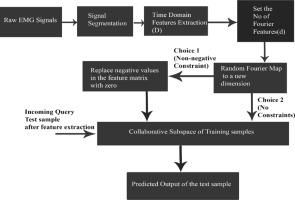IRBM ( IF 4.8 ) Pub Date : 2020-08-13 , DOI: 10.1016/j.irbm.2020.08.003 M. Arunraj , A. Srinivasan , S.P. Arjunan

|
Anticipated hand movements of amputee subjects are considered difficult to classify using only Electromyogram (EMG) signals and machine learning techniques. For a long time, classifying such s-EMG signals have been considered as a non-linear problem, and the problem of signal sparsity has not been given detailed attention in a large set of action classes. For addressing these problems, this paper is proposing a linear-time classifier termed as Random Fourier Mapped Collaborative Representation with distance weighted Tikhonov regularization matrix (RFMCRT). RFMCRT attempts to tackle the non-linear problem via Random Fourier Features and sparsity issue with collaborative representation. The projection error of Random Fourier Features is reduced by projecting to the same dimension as the original feature space and later finding the collaborative representation, with an optional non-negative constraint (RFMNNCRT). The proposed two classifiers were tested with time-domain features computed from the EMG signals obtained from NINAPRO databases using a non-overlapping sliding window size of 256 ms. Due to the random nature of our proposed classifiers, this paper has computed the average and worst-case performance for 50 trials and compared them with other reported classifiers. The results show that RFMNNCRT (average case) outperformed state-of-the-art classifiers with the accuracy of 93.44% for intact subjects and 55.67% for amputee subjects. In the worst-case situation, RFMCRT achieves considerable performance for the same, with the reported accuracy of 91.55% and 50.27% respectively. Our proposed classifier guarantees acceptable levels of accuracy for large classes of hand movements and also maintains good computational efficiency in comparison to LDA and SVM.
中文翻译:

使用表面肌电信号识别截肢者预期手部运动的实时线性时间分类器方案
仅使用肌电图 (EMG) 信号和机器学习技术很难对截肢受试者的预期手部运动进行分类。长期以来,对此类 s-EMG 信号进行分类一直被认为是一个非线性问题,而在大量动作类中,信号稀疏性问题并未得到详细关注。为了解决这些问题,本文提出了一种线性时间分类器,称为具有距离加权 Tikhonov 正则化矩阵 (RFMCRT) 的随机傅立叶映射协作表示。RFMCRT 尝试通过随机傅立叶特征和协同表示的稀疏问题来解决非线性问题。通过投影到与原始特征空间相同的维度,然后使用可选的非负约束 (RFMNNCRT) 找到协作表示,可以减少随机傅立叶特征的投影误差。使用 256 ms 的非重叠滑动窗口大小,使用从 NINAPRO 数据库获得的 EMG 信号计算出的时域特征对提出的两个分类器进行了测试。由于我们提出的分类器的随机性,本文计算了 50 次试验的平均和最坏情况的性能,并将它们与其他报告的分类器进行了比较。结果表明,RFMNNCRT(平均情况)优于最先进的分类器,完整受试者的准确率为 93.44%,截肢受试者的准确率为 55.67%。在最坏的情况下,RFMCRT 实现了可观的性能,报告的准确率分别为 91.55% 和 50.27%。与 LDA 和 SVM 相比,我们提出的分类器保证了大类手部运动可接受的准确度水平,并且还保持了良好的计算效率。



























 京公网安备 11010802027423号
京公网安备 11010802027423号